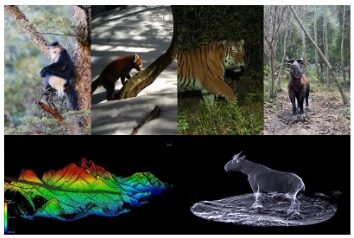

Knowledges about processing of interactions within organisms, between organisms and environment form bedrock of understanding how ecosystem organized. Interactions in forest ecosystem are inferred from patterns of spatial-temporal co-occurrence or avoidance in physical space. Based on the complexity of three-dimensional (3D) ecosystem, ecologists urgently need accurate in-situ data to construct nonlinear relationships and describe complex interacting systems. The reconstructed 3D ecosystem structure provides accurate in situ data to help us description interactions in a unified dimension. We investigated the capability of lidar-derived metrics to characterize the topography and forest structure around denning trees utilized by the Pacific fisher (Martes pennanti) in the Sierra Nevada Mountains, using Classification and Regression Trees (CART) for analysis. The results revealed a strong correlation between fisher denning activities and the surrounding forested environment, with optimal classification accuracies around 20m, and emphasized the value of lidar remote sensing in mammal habitat studies(Feng et al., 2012). After that, we explored the utility of LiDAR-derived variables in ecological niche modeling to determine the spatial distribution of the fisher (Martes pennanti) in the southern Sierra Nevada Mountains, California. By comparing various modeling methods and assessing them based on AUC and Fpb metrics, the findings suggest that incorporating both climate and LiDAR-derived variables enhances model accuracy, underscoring the potential of LiDAR in ecological niche modeling(Zhou et al., 2018).
Although, reconstruction of 3D environment structure has gradually become an effective means for ecologists to study the interaction, research on 3D animal structure has lagged. We provided a 3D animal remote sensing platform combined with multi-platform lidar can obtain the 3D structure of animals and environment, which not only fills the blank of obtaining 3D animal structure data in the wild, but also forms a complete 3D ecosystem structure including animal and environment information. Under the premise of reconstructing 3D ecosystem structure, it is possible to develop complex interaction systems, and base on the process of interaction between animals and environment to promote the further development of animal 3D ecology.